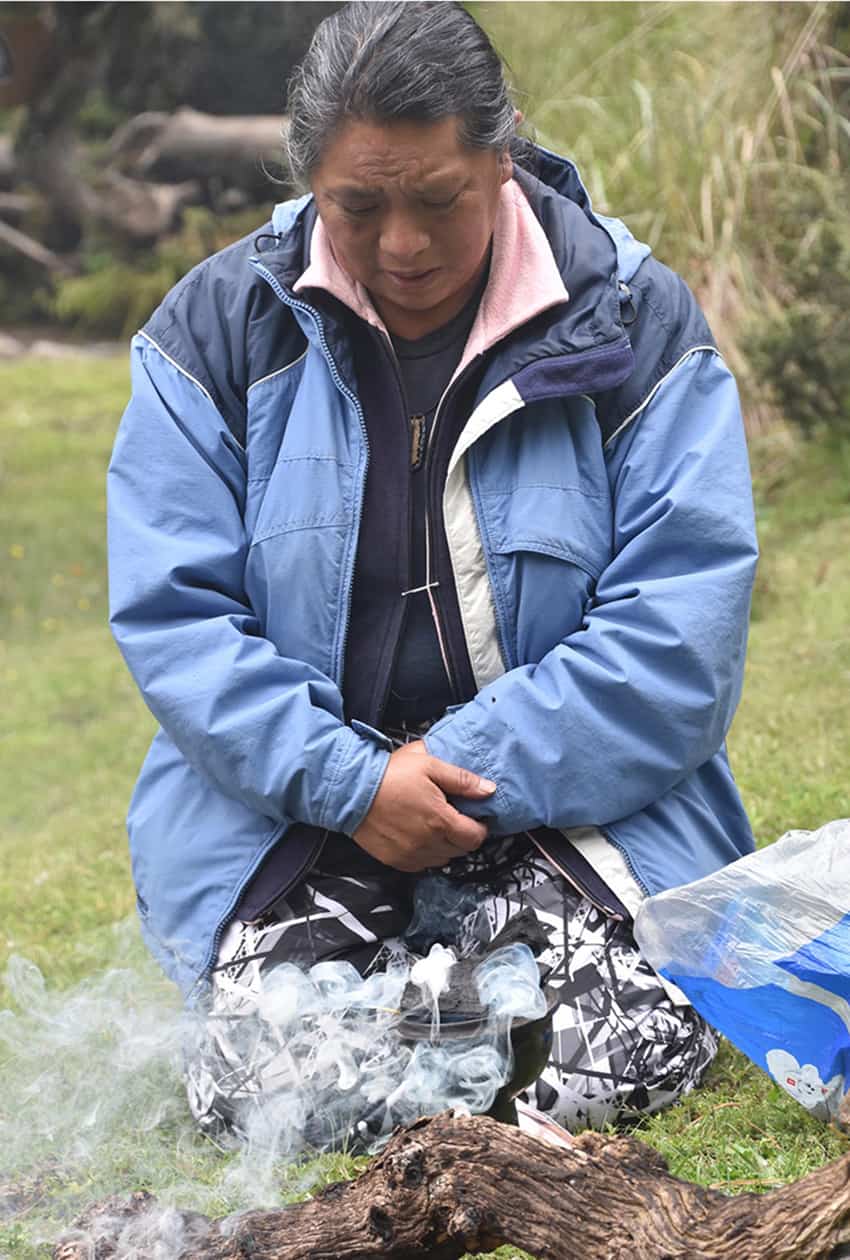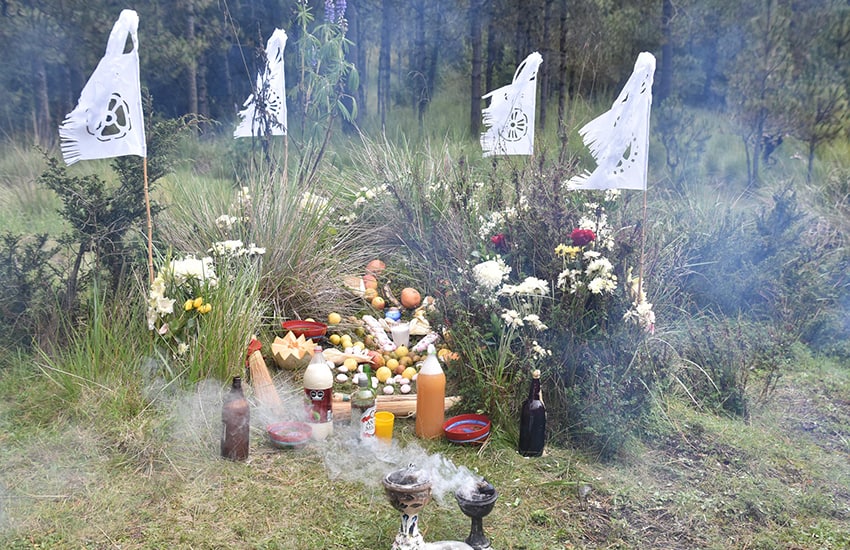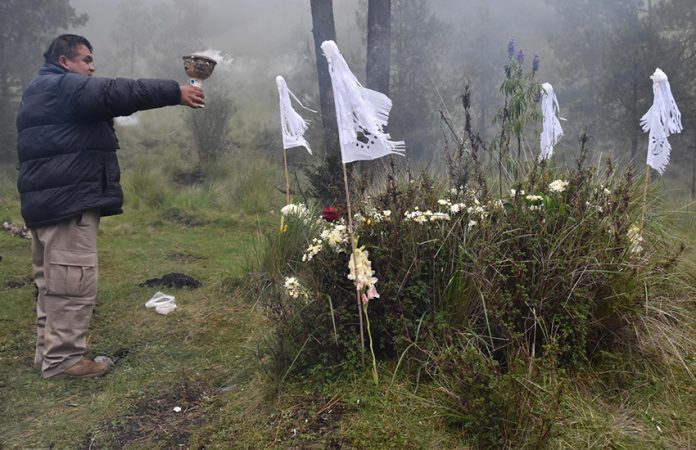“Balance is important in indigenous beliefs,” said Javier as around him, graniceros, traditional Mexican shamans charged with controlling the weather, began unpacking the offerings for a ceremony called the Canícula. “The Canícula is a ritual that attempts to achieve that balance.”
Not just the ritual’s name, the canícula is also the period from early July through mid-August, the dog days of summer, when Sirius the Dog Star (which also bears the name canícula in Spanish), rises and sets with the sun.
Throughout May, graniceros perform rituals to bring rain, hoping to ensure a good harvest. During the dog days, they perform the Canícula, aiming to mitigate damage to crops from the high heat and heavy rains.
“During this time, because of the excess rain and humidity, plants begin to rot,” said Gerardo, the granicero who organized the ritual in a México state pueblo. “If we do not remove it, the plants rot in the heat and animals begin to die. We are [doing this] so that it doesn’t hurt us so much. We are going to leave an offering and ask that they let the animals and flowers live.”
In exchange for being interviewed and photographed about this important ritual, the graniceros asked that only first names be used and that the ritual’s location not be revealed.

Graniceros believe that spirits — particularly those that live in Popocatépetl, an active volcano, and Iztaccihuatl, an extinct one, both of which overlook the Valley of México — communicate with them through dreams. Among other things, spirits tell them what to do to prepare for rituals, what to bring and where to hold them.
“[Another granicera] dreamed that she was in this cave and there was a man selling sweets,” said Gerardo, “and he said, ‘I give you a cross. Tell everyone to put it in their houses as protection so that sickness doesn’t enter the houses.’”
Gerardo called Javier and others participating in the ritual and told them that before the ritual, they should make a small cross from the wood of an ocote pine tree.
“The wood is also used … to start fires in homes and to light incense,” said Javier. The cross he requested — known as a Cruz de Ocote — is often kept in homes as protection from evil spirits.
Although not a granicero, Javier has attended three other rituals, and he’s had dreams before some of them. Before the Canícula, he told me, “I dreamed of guayaba preserves, and Gerardo said that meant that I was to bring that to the ceremony.”
Gerardo told Javier that he believes that the volcanoes are sending him those dreams in order to communicate with him.
Shortly before the Canícula, Esmeralda, a granicera who helped conduct the ritual, had a dream about her sister and a road:
“The road was very bad, and we had to go through ravines and descend with ropes,” she said. “And I told her [my sister], ‘It is better if we go by another road.’ [The spirits] were advising us that the road was very bad.”
On the day of the ritual, a caravan of four 4 x 4s struggled to ascend a dirt road that had become deep mud, nearly impassable. At one point, the caravan had to continue the ascent on a different road, and twice, a chain was wrapped around trees so that the Jeeps could be pulled up inclines.
The initial plan was to hold the Canícula outside a cave, one that has been used for rituals since pre-Hispanic times. But because of a two-hour delay caused by the mud, there was no way to reach it and return during daylight and it was too difficult a descent to make in the dark.
But the spirits had sent Esmeralda another message through her dreams. She had dreamed of a woman descending a mountain on a horse.
“[The spirits] would not let us arrive at the cave because the woman, who was Iztaccihuatl, was going to descend for the offering,” she said.

When the caravan arrived at a site beside a stream fed by snowmelt from Iztaccihuatl, Esmeralda knew we’d arrived at the right place.
As soon as the caravan arrived, participants began to hurriedly set out the offerings. The ceremony had to begin at noon.
“The spirits live under the ground,” said Gerardo. “At midday, the spirits can leave the ground … we attract them with offerings.”
Food and drink were placed on the ground, and Jaime, another granicero and Esmeralda’s husband, placed four small white flags at the corners.
“The flags, called plantli in Náhuatl, represent the four cardinal points and the four basic elements of water, earth, fire and wind,” he explained.
Once everything was set, Esmeralda and Jaime purified the area with copal, an incense.
“The spirits of nature like the smell of copal,” Gerardo said. “Through incense, apart from consecrating things, it is a way to have a dialog with them. With copal, they are always attentive.”
Gerardo then took the incense and, standing before the offerings, asked permission of the spirits to begin the ritual.
“The prayer … is a way of waking those beings,” he said, adding that it was also to remind the spirits that they and indigenous groups had made an agreement ages ago. “We give them a part of what we take from the land: food and some drink. They give us part of the richness that is the water and all of the edible and inedible plants.”
After Gerardo finished with the prayer, each participant knelt before the offerings with an incense burner. “During the welcoming ceremony, a person says their name and where they are from,” said Javier. “This is so the spirits know who they are and can find them.”
Participants then moved away from the offerings so that the spirits could partake of them. After eating food that the group had brought, everyone returned to where the offerings had been set out, some of which were eaten.
This is done because graniceros believe that it’s important to share the offerings with the spirits. But some of the offerings, like the mole verde that Esmeralda had dreamed about and brought, were left for only the spirits to consume.
At 3 p.m., Gerardo performed a ceremony to bring the ritual to a close. He said it was important to end the ceremony at that particular hour.
“At 3:00, unfavorable spirits begin to leave [the ground]. It is important to keep the two [spirits] separated. If the ritual ends later than 3:00, things go badly. We cannot stay longer. We cannot leave the spirits out. They have to return to where they were, and [at] another time, we will attract them with offerings. We will call them.”
As we packed up to leave, a dense fog started rolling in and the temperature dropped dramatically. It’s not clear if this signaled the arrival of the unfavorable spirits, but no one seemed to tarry.
Joseph Sorrentino, a writer, photographer and author of the book San Gregorio Atlapulco: Cosmvisiones and of Stinky Island Tales: Some Stories from an Italian-American Childhood, is a regular contributor to Mexico News Daily. More examples of his photographs and links to other articles may be found at www.sorrentinophotography.com He currently lives in Chipilo, Puebla.
